Ruffneck Constructivists: ICA Philadelphia
by Joshua Michael Demaree
Known for her famed silhouette tableaux that hang in museums around the world, Kara Walker is an artist and professor that has yet to complete that all-important art world trifecta of multitasking. That is, until now. From February 12 until August 16, Walker’s first curated show, Ruffneck Constructivists, is on view at the University of Pennsylvania’s Institute of Contemporary Art in Philadelphia.
Ruffneck Constructivists is two equal parts proposal and love letter. Named for an MC Lyte song from 1993—“Ruffneck” from the rapper’s Ain’t No Other album—it is clear that Walker took Lyte’s refrain to heart: “Gotta what, yo? / Gotta get a ruffneck.”1 Fifteen years after the fact, Walker has compiled her own band of admired ruffnecks: Dineo Seshee Bopape, Kendell Geers, Arthur Jafa, Jennie C. Jones, Kahlil Joseph, Deana Lawson, Rodney McMillian, William Pope.L, Tim Portlock, Lior Shvil, and Szymon Tomsia.
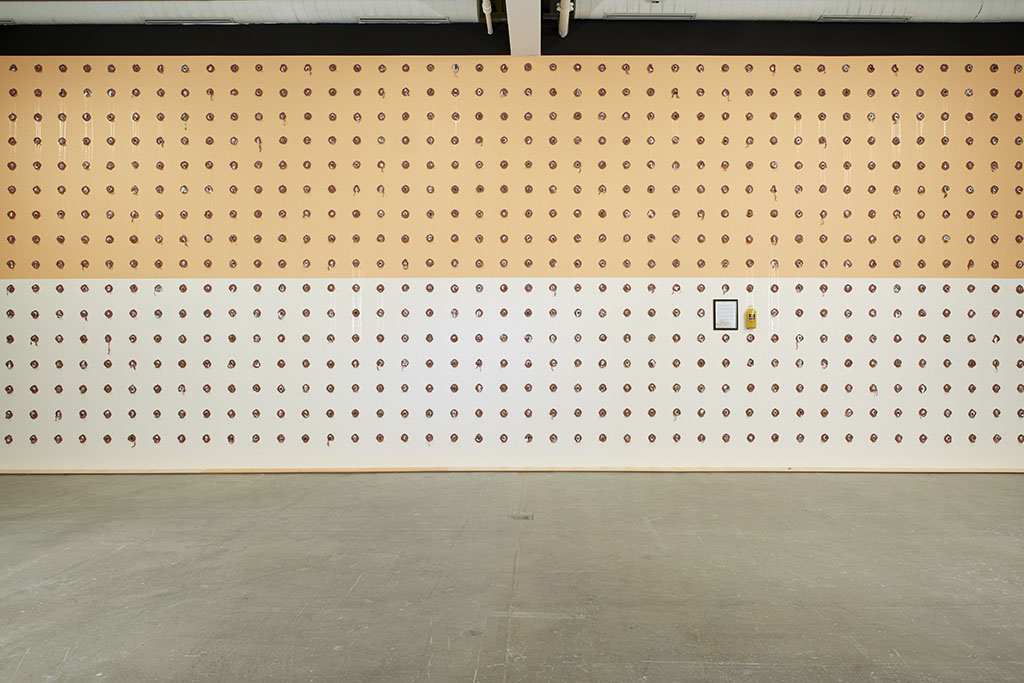
But for Walker, it is not enough to just be a ruffneck, she wants to see what kind of world this group can build, what a ruffneck new world order chaos might look like. Walker has said about the exhibition that she was interested to see what form a black architecture might take. This isn’t about being black per se (several artists in the show are not black), but about being able to envision othered spaces that allow for a range of voices.
The exhibition’s title also alludes to the Russian Constructivist movement from the 1920’s that aimed to put forth a philosophy of architecture and design that shifts attention away from the autonomous whole (i.e. the building) and towards the essential elements of construction (i.e. the materials). Born from the Russian Revolution of 1919, which put the Bolsheviks into power, constructivism held art as a social function, that it should illustrate the philosophy of revolution: namely, that society (i.e. the building) is nothing without the input of each individual (i.e. the materials). Walker is staging her own kind of revolution.
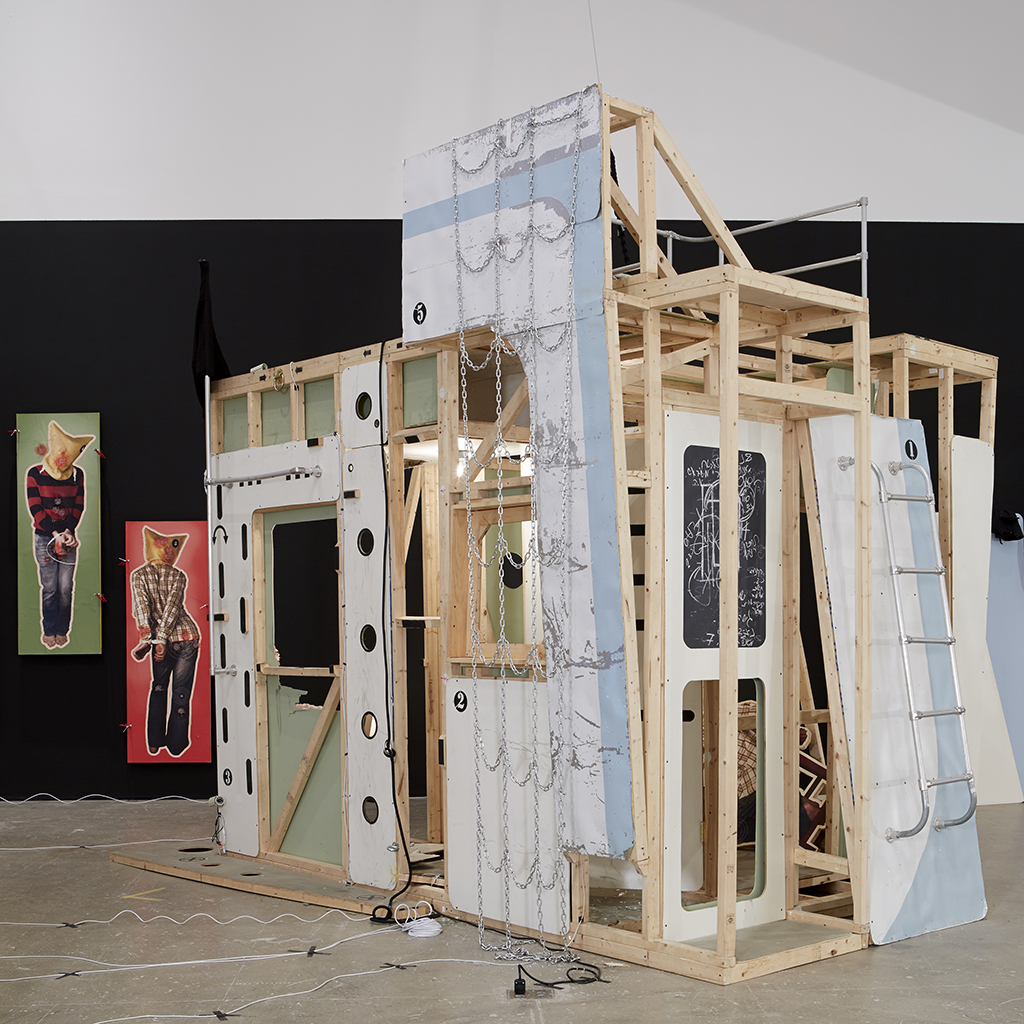
Ruffneck Constructivism isn’t really about constructing in the same sense as Russian Constructivism—rather, it is more of a construction through destruction. Lior Shvil’s Operation OZ Belev-Yam, which occupies half of the gallery’s back room, illustrates this perfectly. The structure isn’t so much a structure as a collection of materials. Difficult to see in photographic reproductions, Shvil’s installation is laid out like an obstacle course. Off to the right is a small changing station with tactical gear. Whereas structures are generally made for protection, this one was built with invasion in mind—a political statement on the creation of Israel, Shvil’s birth country. While he isn’t black, this is the black architecture Walker aims for—one born from anger, injustice, and destruction.
Walker and MC Lyte were not the only voices playing in my head during the opening. Two days prior, the famed British cultural theorist Stuart Hall passed away. Hailed as the “godfather of multiculturalism,” Hall grew up in Kingston, Jamaica, but lived and worked in the United Kingdom. He would go on to found the New Left Review, and his ceaselessly growing oeuvre of critical essays would harbor the rise of cultural and critical studies in academic disciplines around the world. It was Hall and his counterparts that turned multiculturalism into everyone’s responsibility, a responsibility that Walker takes intensely serious.
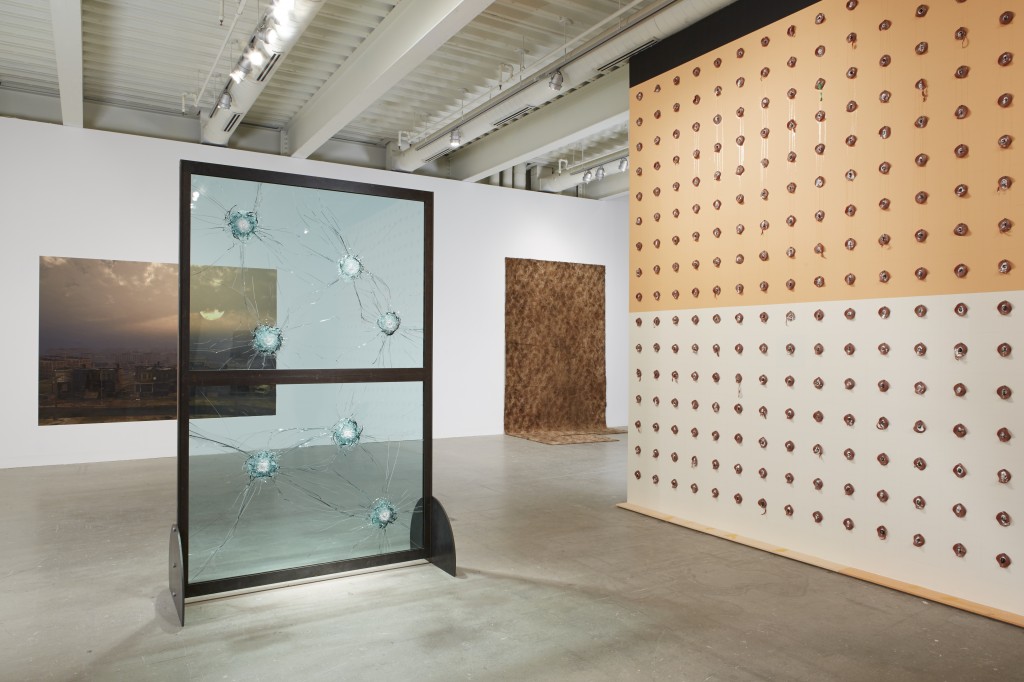
In particular this exhibition made me think back to an essay, “What is this ‘black’ in black popular culture?,” that Hall wrote in the same year MC Lyte released “Ruffneck.” As an undergraduate, I read the article and was taken with one passage in particular:
… if the global postmodern represents an ambiguous opening to difference and to the margins and makes a certain kind of decentering of the Western narrative a likely possibility, it is matched, from the very heartland of cultural politics, by the backlash: the aggressive resistance to difference… the return to grand narratives of history, language, and literature (the three great supporting pillars of national identity and national culture… Part of the problem is that we have forgotten what sort of space the space of popular culture is… It is therefore necessary to deconstruct the popular once and for all. There is no going back to an innocent view of what it consists of.2
Hall is getting at the same point Walker does: it isn’t enough to hear disparate voices; they have to have a space, they have to demand a seat at the table. This is what I thought when I put a post-it with the words “DECONSTRUCT THE POPULAR” above the desk in my dorm room. This is likely what Walker thought when compiling her team of ruffnecks to take Hall’s argument one step further: rather than stepping up to the table, they take a wrecking ball to the entire house.
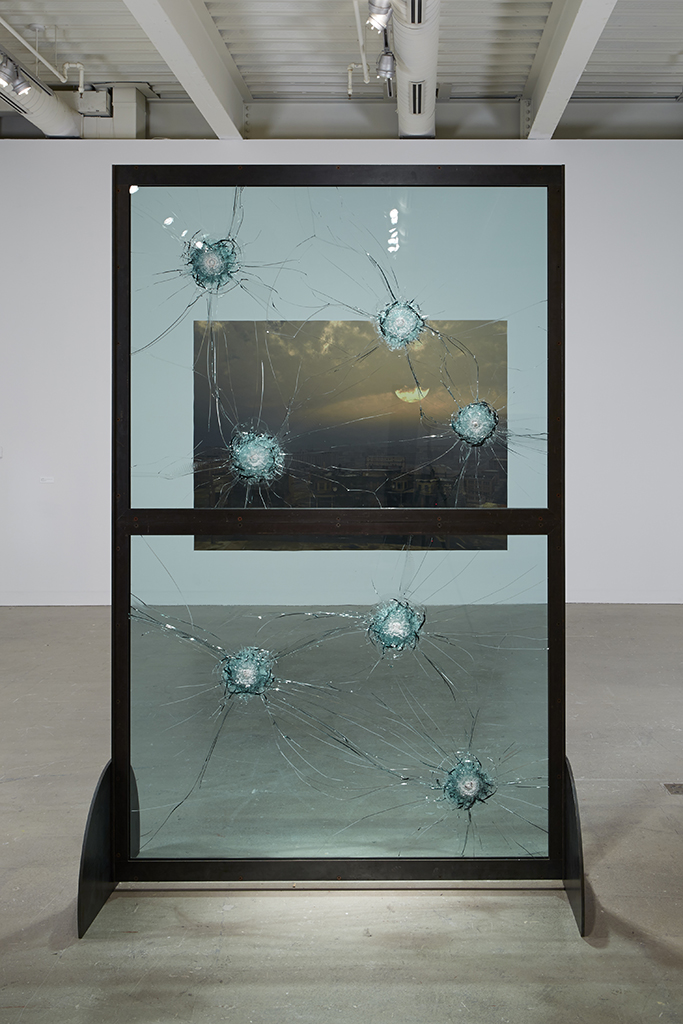
This can be seen in one of the exhibition’s centerpiece, Kendell Geer’s Stripped Bare. Standing just inside the gallery, Stripped Bare is an homage to Duchamp’s famed The Bride Stripped Bare by Her Bachelors, Even (more commonly known as The Large Glass, which sits two miles away in the Philadelphia Museum of Art). Typically, Geer’s work is heavy-handed and blunt (and plastered with the word “FUCK”). What he strips bare in this piece are two enclosed glass panes that forgo any of the figurations found in The Large Glass and, like the storied cracks of Duchamp’s piece, Geers took a gun to his panes—simultaneously building upon the history of modern art and tearing it down execution-style.
What makes Geer’s piece so striking as one of the show’s focal points is that it creates both the figurative and literal lens through which the rest of the exhibition can be seen. As seen in the installation views, it perfectly frames a print by Tim Portlock, titled Sunrise-the extended constructivists re-render, on the wall directly behind. What first appears as a photograph of a disadvantaged and derelict cityscape (common in the age of “decay porn” photography) reveals itself as a digital composition, a kind of Sim City game-over scenario.
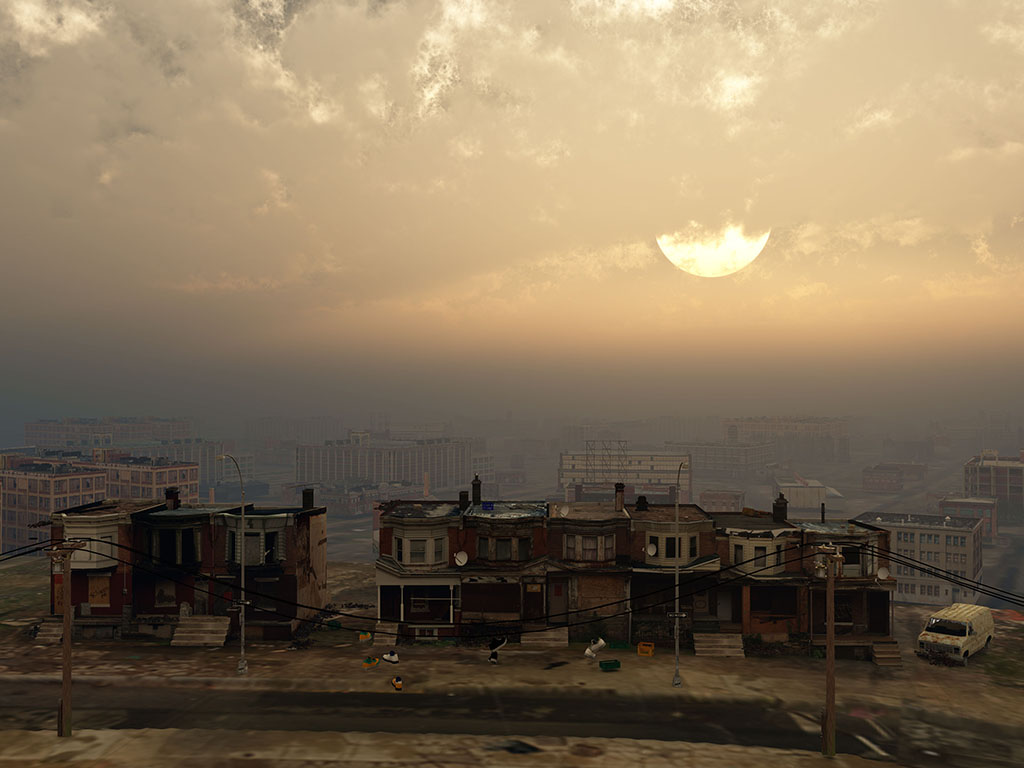
Cutting right through Geer’s gun shot holes, Portlock depicts urban blight with the hazy romanticism of the Hudson River Valley school of Luminism, the American cousin to Impressionism. The two pieces play back and forth nicely—it requires no stretch of the imagination to envision Stripped Bare as not another allusion to Duchamp’s work but rather just another window in a condemned North Philly home.
Many of the artists within the exhibition—Geers, Portlock, Shvil, and McMillian, in particular—fall under the realm of what my friends and I call “dude art”: a showy, one-note kind of aesthetic that makes a fantastic postcard. Its meaning is often direct and unapologetically blunt, which leaves little fodder for heavy-handed curators or reviewers like myself. Yet, under Walker’s curation, which feels respectfully hands-off, their in-your-face politicism is a jolt of energy, especially when appearing en masse.
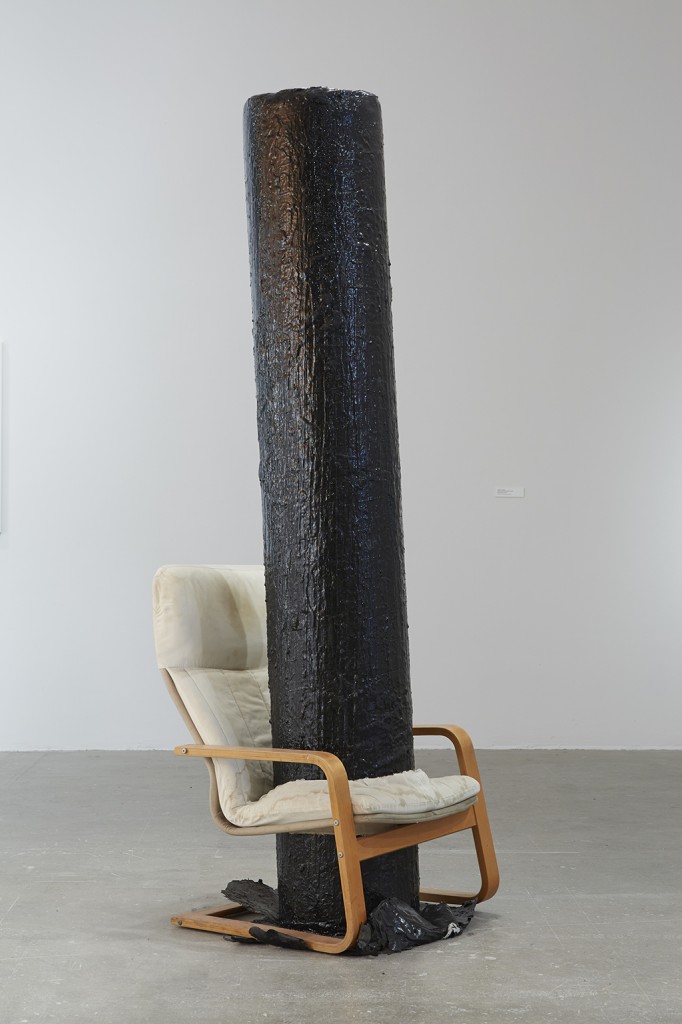
A piece like Rodney McMillian’s chair with a giant latex-covered cardboard tube sticking through it is so blatantly sexual and racial that its most interesting quality is its presence, its constant demand of space within the gallery. Few pieces could vie for attention with Geer’s Stripped Bare or William Pope.L’s Claim, a wall of 688 slices of baloney upon which are pasted the faces of Philadelphia residents—yet Walker pulls off a feat of orchestration by allowing the three pieces to shuffle the front room’s focal points. After all, single-voiced grand narratives are a keystone of modernism—ruffneck constructivism needs to be both brash and still be able to share the mic.
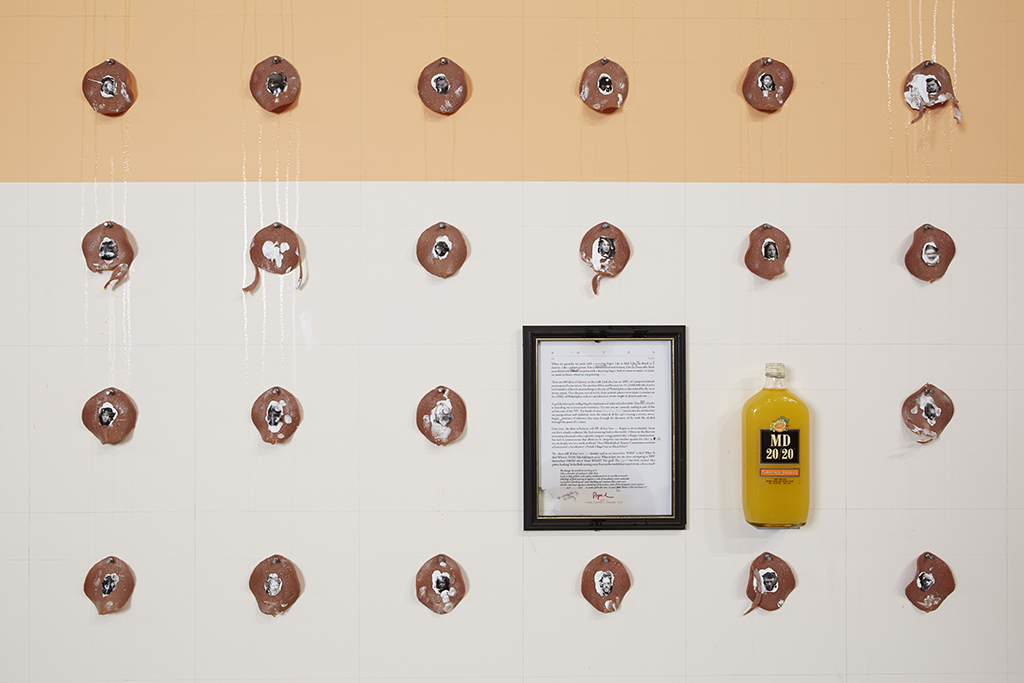
The explanatory text in Claim notes that the number of slices is representative of 1% the number of Jewish residents in Philadelphia. Arranged on a grid (and expertly coupled in both form and argument with a portrait series by Deana Lawson on the wall’s verso), Pope.L reconstructs our practices of social mapping—forming a kind of anti-infographic. He reminds us that just because bodies can be counted does not mean their lives can be accounted for in numbers and charts. The wilting and sweating baloney fill the gallery with the stink of racial and classist innocence, reminding us all that going backwards is not an option.
There are several other fantastic pieces in the exhibition, including several photographs from Deana Lawson and two videos from Kahlil Joseph, and the space as a whole feels refreshingly under-curated. Walker does not attempt to create any grand narrative; her’s is a chorus of ruffnecks. The same way a group of people talking creates a dissonant, unmelodious yammering, this is the choir to welcome the new world chaos. In 1993, Stuart Hall called for an imminent critique of culture at the same moment MC Lyte demanded a ruffneck, someone to throw all the rules to the wind. Fifteen years later and not a moment too late, Walker has answered the call: “Gotta what, yo? / Gotta get a ruffneck.”
Ruffneck Constructivists, curated by Kara Walker, will be on view at the ICA through August 16th.
- “Ruffneck” performed by MC Lyte from the album Ain’t No Other. Song written by Aqil Davidson / Lana Michele Moorer / Walker Scott / Markell Demont Riley. Lyrics © EMI Music Publishing.
- “What is this ‘black’ in black popular culture? (Rethinking Race)” by Stuart Hall. Social Justice, Spring-Summer, 1993.